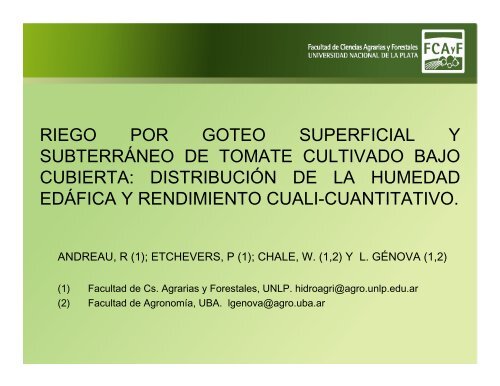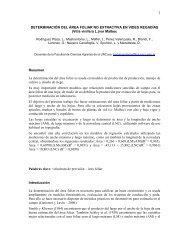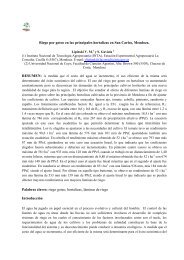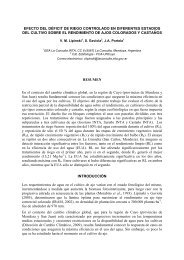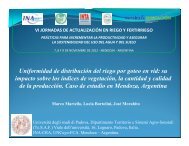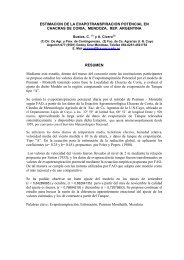riego por goteo superficial y subterráneo de tomate cultivado bajo ...
riego por goteo superficial y subterráneo de tomate cultivado bajo ...
riego por goteo superficial y subterráneo de tomate cultivado bajo ...
Create successful ePaper yourself
Turn your PDF publications into a flip-book with our unique Google optimized e-Paper software.
RIEGO POR GOTEO SUPERFICIAL Y<br />
SUBTERRÁNEO DE TOMATE CULTIVADO BAJO<br />
CUBIERTA: DISTRIBUCIÓN DE LA HUMEDAD<br />
EDÁFICA Y RENDIMIENTO CUALI-CUANTITATIVO.<br />
ANDREAU, R (1); ETCHEVERS, P (1); CHALE, W. (1,2) Y L. GÉNOVA (1,2)<br />
(1) Facultad <strong>de</strong> Cs. Agrarias y Forestales, UNLP. hidroagri@agro.unlp.edu.ar<br />
(2) Facultad <strong>de</strong> Agronomía, UBA. lgenova@agro.uba.ar
OBJETIVOS<br />
• Diseñar tres sistemas <strong>de</strong> <strong>riego</strong> <strong>por</strong> <strong>goteo</strong>, uno<br />
<strong>superficial</strong> y dos <strong>subterráneo</strong>s con distinta<br />
profundidad <strong>de</strong> emisión, para regar un cultivo <strong>de</strong><br />
<strong>tomate</strong> conducido <strong>bajo</strong> cubierta.<br />
• Medir la distribución <strong>de</strong> la humedad <strong>de</strong>l suelo <strong>de</strong>ntro<br />
<strong>de</strong>l camellón.<br />
• Evaluar la respuesta productiva <strong>de</strong>l <strong>tomate</strong> <strong>bajo</strong><br />
cubierta a las tres modalida<strong>de</strong>s <strong>de</strong> <strong>riego</strong> <strong>por</strong> <strong>goteo</strong>.
MATERIALES Y METODOS<br />
• Invernáculo <strong>de</strong> ma<strong>de</strong>ra y plástico, ubicado en Los Hornos,<br />
Pdo. <strong>de</strong> La Plata, Pcia. <strong>de</strong> Bs. Aires.<br />
• Camellones <strong>de</strong> tierra fertilizada <strong>de</strong> 40 m <strong>de</strong> longitud, 0,8 m <strong>de</strong><br />
base y 0,4 m <strong>de</strong> altura, con 2 plantines <strong>de</strong> <strong>tomate</strong> Elpida <strong>por</strong><br />
metro cuadrado.<br />
• Dos cintas <strong>de</strong> <strong>goteo</strong> Aquatraxx <strong>de</strong> Ø=22 mm, en paralelo sobre<br />
y <strong>de</strong>ntro <strong>de</strong>l camellón, espaciadas 0,2 m, con 5 orificios<br />
emisores <strong>por</strong> m, Q=0,009 m³ /h m, P= 0,8 bar.<br />
• Tratamientos: T1 Goteo <strong>subterráneo</strong> a 12,5 cm <strong>de</strong> profundidad,<br />
T2 Goteo <strong>subterráneo</strong> a 25 cm <strong>de</strong> profundidad, T3 Goteo<br />
<strong>superficial</strong>.
MATERIALES Y METODOS<br />
• Sensores <strong>de</strong> humedad volumétrica Decagon EC-5 instalados a<br />
5, 10, 20 y 30 cm <strong>de</strong> profundidad y 0, 15 y 30 cm <strong>de</strong> distancia<br />
al eje <strong>de</strong>l camellón, con 3 repeticiones.<br />
• Diseño experimental en bloques enteramente al azar con 10<br />
repeticiones para datos <strong>de</strong> cosecha; rendimiento total <strong>de</strong><br />
<strong>tomate</strong>s <strong>por</strong> planta, número <strong>de</strong> <strong>tomate</strong>s <strong>por</strong> planta y peso<br />
medio <strong>de</strong> frutos.<br />
• Análisis estadístico <strong>de</strong> los datos: a) <strong>de</strong> humedad: mo<strong>de</strong>lo <strong>de</strong><br />
análisis <strong>de</strong> variancia factorial general y técnicas <strong>de</strong><br />
comparación múltiple <strong>de</strong> medias observadas a posteriori <strong>de</strong><br />
Tukey y Bonferroni, b) <strong>de</strong> cosecha: análisis <strong>de</strong> varianza, test<br />
<strong>de</strong> Tukey para rendimiento y peso medio <strong>de</strong> fruto y prueba no<br />
paramétrica <strong>de</strong> Kruskall Wallis para número <strong>de</strong> frutos.
Ubicación <strong>de</strong> cintas <strong>de</strong> <strong>goteo</strong> y sensores <strong>de</strong> humedad
Tomate <strong>bajo</strong> cubierta regado <strong>por</strong> <strong>goteo</strong><br />
<strong>subterráneo</strong> y <strong>superficial</strong>
Medición <strong>de</strong> la humedad
RESULTADOS<br />
Distribución <strong>de</strong> la humedad <strong>de</strong>ntro <strong>de</strong>l camellón<br />
Capacidad <strong>de</strong> campo Wc= 29,8%<br />
Tratamiento<br />
T1<br />
T2<br />
T3<br />
Wv máxima<br />
%<br />
26,6<br />
30,2<br />
24,9<br />
Profundidad<br />
cm<br />
10<br />
30<br />
5
Valores medios <strong>de</strong> humedad <strong>de</strong>ntro <strong>de</strong>l camellón.<br />
T 1 Goteo <strong>subterráneo</strong> a 12,5 cm <strong>de</strong> profundidad<br />
Profundidad<br />
(cm)<br />
5<br />
10<br />
20<br />
30<br />
T 2 Goteo <strong>subterráneo</strong> a 25 cm <strong>de</strong> profundidad<br />
Profundidad<br />
(cm)<br />
5<br />
10<br />
20<br />
30<br />
T 3 Goteo <strong>superficial</strong><br />
Profundidad<br />
(cm)<br />
5<br />
10<br />
20<br />
30<br />
0<br />
9,8<br />
12,2<br />
20,0<br />
20,2<br />
0<br />
6,6<br />
24,2<br />
24,7<br />
25,5<br />
0<br />
21,3<br />
19,7<br />
20,5<br />
18,1<br />
Distancia (cm)<br />
15<br />
7,9<br />
26,6<br />
24,6<br />
25,2<br />
Distancia (cm)<br />
15<br />
10,5<br />
24,0<br />
28,4<br />
30,2<br />
Distancia (cm)<br />
15<br />
24,9<br />
23,7<br />
21,8<br />
17,0<br />
30<br />
5,5<br />
15,2<br />
20,2<br />
30<br />
6,8<br />
18,9<br />
25,4<br />
30<br />
23,8<br />
22,0<br />
17,0<br />
Promedio<br />
parcial<br />
Promedio<br />
parcial<br />
Promedio<br />
parcial<br />
7,7<br />
18,0<br />
21,6<br />
22,7<br />
7,9<br />
22,4<br />
26,1<br />
27,9<br />
23,3<br />
21,8<br />
19,8<br />
17,5<br />
Promedio<br />
general<br />
17,5<br />
Promedio<br />
general<br />
21,1<br />
Promedio<br />
general<br />
20,6
Profundidad (cm)<br />
T3. Isohumedad (Wv %) <strong>bajo</strong> <strong>goteo</strong> <strong>superficial</strong>.<br />
0 5 10 15 20 25 30<br />
0<br />
5<br />
10<br />
15<br />
20<br />
25<br />
30<br />
Distancia al eje <strong>de</strong>l camellón (cm)
T1. Isohumedad (Wv %) <strong>bajo</strong> <strong>goteo</strong> <strong>subterráneo</strong>. Profundidad 12,5 cm.<br />
Profundidad (cm)<br />
0 5 10 15 20 25 30<br />
0<br />
5<br />
10<br />
15<br />
20<br />
25<br />
30<br />
Distancia al eje <strong>de</strong>l camellón (cm)
T2. Isohumedad (Wv %) <strong>bajo</strong> <strong>goteo</strong> <strong>subterráneo</strong>. Prof. 25 cm<br />
Profundidad (cm)<br />
0 5 10 15 20 25 30<br />
0<br />
5<br />
10<br />
15<br />
20<br />
25<br />
30<br />
Distancia al eje <strong>de</strong>l camellón (cm)
Areas y volúmenes <strong>de</strong> los bulbos húmedos con valores <strong>de</strong><br />
humedad óptima (Wv entre 20 y 29,8%)<br />
1400<br />
1200<br />
1000<br />
800<br />
600<br />
400<br />
200<br />
0<br />
T1 T2 T3<br />
Area (cm2) Volumen (cm3)
Porcentaje <strong>de</strong> incremento <strong>de</strong> áreas y volúmenes <strong>de</strong> los<br />
bulbos húmedos en el rango <strong>de</strong> humedad óptima.<br />
Tratamiento<br />
T1<br />
T2<br />
T3<br />
Area<br />
%<br />
14<br />
42<br />
0<br />
Volumen<br />
%<br />
21<br />
69<br />
0
Respuesta productiva: rendimiento total <strong>de</strong> <strong>tomate</strong>s <strong>por</strong> planta.<br />
T2<br />
T1<br />
T3<br />
Diferencias estadísticamente significativas.<br />
0 1 2 3 4 5 6 7 8 9<br />
Total <strong>de</strong> <strong>tomate</strong>s <strong>por</strong> planta (kg)
Tratamientos<br />
T3<br />
T2<br />
T1<br />
Número <strong>de</strong> <strong>tomate</strong>s <strong>por</strong> planta.<br />
Diferencias estadísticamente no significativas<br />
31,0 32,0 33,0 34,0 35,0 36,0 37,0<br />
Promedio <strong>de</strong> <strong>tomate</strong>s <strong>por</strong> planta.
Tratamientos<br />
T2<br />
T1<br />
T3<br />
Peso promedio <strong>de</strong> <strong>tomate</strong>s <strong>por</strong> planta<br />
Diferencias estadísticamente significativas.<br />
0 50 100 150 200 250<br />
Peso medio <strong>de</strong> <strong>tomate</strong>s (g)
Tomates <strong>por</strong> categoría comercial (%)<br />
Porcentaje <strong>de</strong> <strong>tomate</strong>s cosechados <strong>por</strong> categoría comercial.<br />
100<br />
90<br />
80<br />
70<br />
60<br />
50<br />
40<br />
30<br />
20<br />
10<br />
0<br />
Primera >150 g. Segunda 100-150 g. Tercera
CONCLUSIONES<br />
a) El <strong>goteo</strong> <strong>subterráneo</strong> produjo niveles óptimos <strong>de</strong> humedad<br />
volumétrica media equivalentes al 74 y 85 % <strong>de</strong> la capacidad<br />
<strong>de</strong> campo, en el estrato <strong>de</strong>l camellón entre 8-9 y 30 cm <strong>de</strong><br />
profundidad, superiores al 73 % <strong>de</strong>l <strong>goteo</strong> <strong>superficial</strong>,<br />
distribuido en el estrato <strong>de</strong> 0 a 15-18 cm <strong>de</strong> profundidad.<br />
b) Las áreas y los volúmenes <strong>de</strong> hume<strong>de</strong>cimiento <strong>de</strong>ntro <strong>de</strong>l<br />
camellón en el rango <strong>de</strong> humedad óptima, resultaron<br />
mayores en los dos tratamientos <strong>de</strong> <strong>goteo</strong> <strong>subterráneo</strong>, T1 y<br />
T2 superaron a T3 un 14 y 42 % en área y 21 y 69 % en<br />
volumen, respectivamente.<br />
c) El rendimiento <strong>de</strong> <strong>tomate</strong>s <strong>por</strong> planta producido <strong>por</strong> T2<br />
superó significativamente al <strong>goteo</strong> <strong>superficial</strong>, no existiendo<br />
diferencias significativas entre el <strong>goteo</strong> <strong>subterráneo</strong> a<br />
distintas profundida<strong>de</strong>s.
CONCLUSIONES<br />
• d) El mayor rendimiento <strong>de</strong> frutos <strong>por</strong> planta se <strong>de</strong>bió al<br />
incremento <strong>de</strong>l peso medio <strong>de</strong> <strong>tomate</strong>s y no al número <strong>de</strong><br />
frutos <strong>por</strong> planta.<br />
• e) El rendimiento total <strong>de</strong> <strong>tomate</strong>s y el peso medio <strong>de</strong> frutos se<br />
correlacionaron fuertemente con las profundida<strong>de</strong>s <strong>de</strong> <strong>goteo</strong> y<br />
las áreas <strong>de</strong> los bulbos húmedos con humedad óptima.<br />
• f) Los muy <strong>bajo</strong>s niveles <strong>de</strong> humedad, cercanos al punto <strong>de</strong><br />
marchitez, producidos <strong>por</strong> el <strong>goteo</strong> <strong>subterráneo</strong> en los primeros<br />
10 cm <strong>de</strong> profundidad, disminuyeron la eva<strong>por</strong>ación y la<br />
población <strong>de</strong> nemato<strong>de</strong>s, manteniendo la superficie <strong>de</strong>l<br />
camellón sin malezas.
MUCHAS GRACIAS


